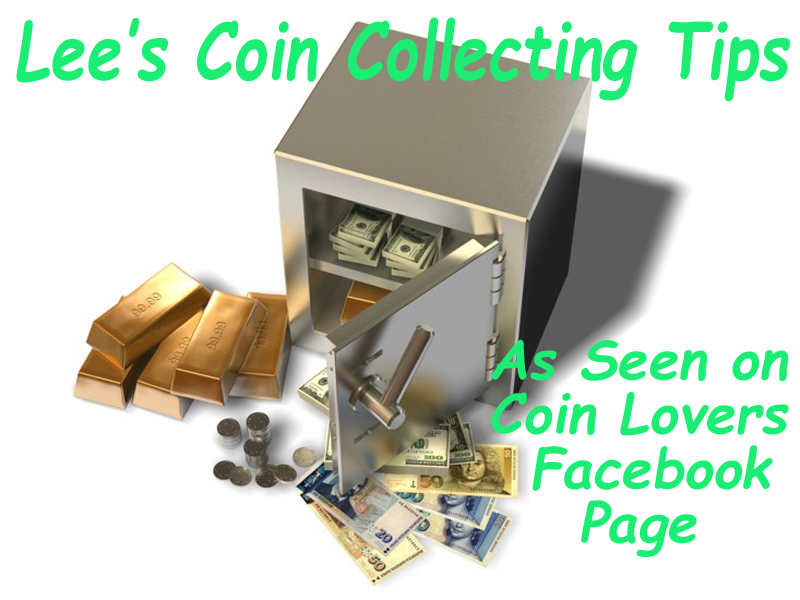

| search engine by freefind |
We would love to hear from you. Suggestions are also welcome.
To contact me, just click-on email below.
Morgan and Peace Silver Dollars are where you find VAMs. It's an acronym for "Van Allen - Mallis" and refers to die varieties involving date and mint mark. This system's goal is to catalog every die variety found. That's quite a task since new VAMs are still being found.
According to the fine website Vam World, "VAM-1 is always the normal die state for a specific date/mint and has no distinguishing characteristics. Die varieties that can be distinguished from each date/mint's VAM-1 are subsequently numbered incrementally (VAM-2, VAM-3, etc.) Sometimes a letter follows the number, i.e. VAM-1A. A "lettered" VAM represents a later stage of the numbered die that has a die gouge, major die crack, pitting, die clash, or any other result of a post-die-production occurence [sp] that can be shown to have changed the die. Like VAM numbers, letters are also assigned in a one-up fashion.
"Keep in mind that VAM numbers for a specific date and mint mark are exclusive to that date and mint mark. There is no crossover. For example, an 1880-O VAM-2 does not have the same distinguishing characteristics as a 1882-S VAM-2." Fortunately this website carries a list of the top VAMs.
You can even join the Society of Silver Dollar Collectors (SSDC) to keep up with the latest VAMs. More information can be found on Vam World.
Before you ask, "Yes I do have a VAM - 1882 Morgan Silver Dollar Vam-25, which has a doubled "2" on the date.
Like other varieties and errors, VAMs are a bit pricier than "normal" coins, but it's a neat specialty.
© 2016
Called worthless by some, these rather common types of doubling are NOT Double Dies. In reality, these occurrences are due to damage. As a result, they don't carry any additional value, although some folks do collect them.
Common doubling varieties usually fall into three (3) categories: Mechanical, Die Fatigue, and Abrasion. Let's carefully look at each of these types of doubling.

Mechanical Doubling is the most common of the three and goes by various names such as machine doubling, strike doubling, etc. Basically a flat second/duplicate image appears on a raised design element. This doubling is a result of loose part(s) on the Coining Press. This looseness is inevitable due to the constant heavy pressure pound of the Dies on the coin planchets (blanks). PHOTO: NGC
There are actually four (4) forms of Mechanical Doubling: Push, Slide, Ejection, and Rim-Restricted Design Duplication.

Die Fatigue Doubling, aka Die Deterioration Doubling happens when Dies are not replaced in a timely manner and begin to wear and fail due to the actual process of minting. Even though the problem is on the Die, this too is NOT a Double Die Error. Primarily found on nickels and cents, the actual problem occurs when the metal alloy(s) resist flowing into all areas of the Die causing fatigue, aka wear, to the Die. PHOTO: error-ref.com
Abrasion Doubling Debunked: two (2) types of abrasion doubling were defined by Alan Herbert, 1) inside abraded die doubling and, 2) outside abraded die doubling.
Inside abraded die doubling was alleged to be a type of intentional modification applied to a working die. An abrasive was said to be used to restore and enlarge letters that had lost clarity due to die wear. This form of abrasion doubling has been shown not to exist. All purported examples of inside abraded die doubling are clearly cases of die deterioration doubling.
Outside abraded die doubling: was said to be an occasional side effect of intentional die abrasion ("die polishing", "stoning", "lapping"). Such a procedure is undertaken to remove light clash marks and other superficial damage. Application of an abrasive was said to move metal around so as to create a secondary image. This form of doubling has also proven to be a myth. Most purported examples are simply cases of die deterioration doubling.
The most dramatic alleged case (shown below) also was determined to be the result of die wear.


This 1971 cent shows the development of secondary, incomplete letters and numbers.
Set of secondary letters is found above the rty of Liberty. Incomplete, secondary 9 and 7 are found above the middle two digits of the date. Secondary elements have an irregular, beaded appearance. Similar-appearing clusters of microscopic bumps appear elsewhere on the design. PHOTOS: error-ref.com
Buyer Beware - Know the folks from which you buy and educate yourself BEFORE buying any coin, especially errors. Study photos of actual errors in a current edition of "The Cherrypickers Guide To Rare Die Varieties Of United States Coins" and other reliable sources.
For additional information on Doubling, view my two-part video series, Doubled Dies vs. Doubling. Part 1 can be found at https://youtu.be/LO_jrhsI47Q and Part 2 can be found at https://youtu.be/8r7XzvoweWY . Enjoy!
Originally appeared in 2016 and has been updated.
© 2022
Here are two (2) more fairly common errors.
DOUBLE STRIKE

This error occurs when the die(s) strike(s) the planchet, bounces and strikes it a second time.
REPUNCHED MINTMARK (RPM) or DATE
RPM - For many years the mintmark was literally "hand-applied" to the die with a hardened metal punch. If not precise, it shows was as a ghost or partial mintmark. This process ended in 1986 when the U.S. Mint began adding the mintmark to the master die.
DATE - This is a result of one or more numbers in the date became weak from too many strikes, and/or had never punched deep enough. So, the die was re-punched for more detail, but when it was even a little bit off, it appears as a partial or ghost numeral(s).

Shown is a RPM - notice the repunched S at about 7 o;clock.
Originally appeared in 2016 and has been updated.
© 2022
Weak letters and numerals are somewhat common. Examine enough coins and you'll find some.


They are fun and inexpensive to collect. Plus, they help you "get the feel" for spotting errors and unusual traits on coins.
Why not get a roll or two of any denomination from your bank and start your quest to find them. You'll make Indiana Jones proud!
Originally appeared in 2016.
© 2022
Prior to 1981, one of the most common Lesser Varieties was misaligned dates and mint marks. Again, this was due to how they were added to the die before any coins were produced.
As history explains it, only one or two of the numerals of the date were "permanent", with the last two or three added each year the coin was minted. It seems to be a similar case for the mint marks.

There are some very interesting misalignments out there. I search at least 1500 Wheat Cents each month, as well as a number of other coins. There's plenty of these Lesser Varieties to find.
Originally appeared in 2016
© 2022
Unless occurring during the actual minting process, any anomalies you see on coins are Varieties, not Errors. I collect both and enjoy finding Varieties as well as Errors. One advantage with some Varieties is their cost, which is very wallet-friendly.
More to the point, Varieties are intentional or unintentional changes occurring to the die(s) before coins are struck. They can range from RPMs (Repunched Mintmarks) to DDO (Double Die Obverse. It can be a bit confusing since some folks blur the line between Varieties and Errors, while others combine them all as Errors.
Confused? Don't be. I fall into agreement with Ken Potter (http://koinpro.tripod.com/), who I count as a casual friend and well-respected expert in all that is abnormal with coins. He has used the Error-Variety Coins category for a number of years. That is why RPMs, DDOs and the rest appear under my list of Errors.
Where I differ a bit is that I also collect what I consider to be Lesser Varieties. These include numerals in the date and/or the mintmark being out of alignment. I also include in this sub-category errant "blobs" of metal partially covering letters or numbers. These are oft times mistakenly called "cuds", since a "cud" originates and stays connected to the rim.
Since I'm from Nebraska, some of my favorite anomalies are found on the 2006 Nebraska State Quarter and the 2015 ATB Homestead National Park (NE) Quarter. I found snow on the roof and saw a lightning strike on the latter, but more on those later.
Welcome to my wonderful world of Coin Lesser Varieties. Sit back, relax, and enjoy - maybe even learn something new.
Originally appeared in 2016.
© 2022
Lesser Varieties are fun to collect and search for. It also gives the collector a sense of accomplishment when s/he finds one.
I recommend cherry picking through rolls of coins easily obtained at banks. Pick a single denomination and have at it. Why only a single denomination? It allows the collector to develop a familiarity with that denomination.
My specialty is cents. I routinely search a minimum of 50,000+ Wheat and Lincoln cents each year. As a result of doing this, I've developed an "eye" that helps me locate anomalies. That and Lesser Varieties are more common and a cherry picker is rewarded more often. Plus, you never know when you may hit a biggie as I did recently - a true DDO date!
I also occasionally cherry pick my way through rolls of nickels, dimes, quarters and half-dollars. Never know what you might find. I've found 35% Wartime Nickels, as well as silver types of the other denominations.
What are you waiting for? All you need is a 10-20x loupe and an Indian Jones desire to find the prize!
Originally appeared in 2016.
© 2022
I started collecting and studying about Coin Errors about three (3) years ago, and I absolutely love that segment of Numismatics! To me it's the challenge of finding them, to date I've searched through well over 100,000 U.S. coins of every denomination.
It all began with researching Coin Errors via a few classic books on the topic. It was in one of those books that I discovered the names of clubs for error coin collectors in the 1970s. Through the trusty Internet, I found the only association today for error coin collectors is CONECA (Combined Organizations of Numismatic Error Collectors of America). To view their website, click here. I quickly joined and began adding more books and knowledge on coin errors to my arsenal. Today I am the Nebraska State Representative for CONECA.
As a result, I also returned to one of my childhood habits - cherry picking rolls of coins. What fun it still is to me and the tellers of the area banks all know my name. Who says that you can't return to your childhood?
A basic term you need to be familiar with is "planchet" which is nothing more than a blank piece of metal(s) from which coins are made.
To start here is a list and explanation of some basic Coin Errors.
- Off-Center Struck Coins - One of the most common and best known types of errors, which happens when a blank which is supposed to be fed into the press, lands in the collar improperly. It results in only part of the blank being between the upper and lower dies. When the dies strike the blank, only that part will be struck with a design.There are many more errors and varieties then we have time to look at in this Coin Collecting Tip.
Trust me; becoming an error coin collector breathes fresh, high octane air into the hobby I love. Cherry picking through rolls is inexpensive, and makes me feel like coin collecting's answer to Indiana Jones! The basic tools needed to start are probably what you already have: a background cloth, one or more loupes, and white cotton gloves.
As for books, though a bit pricey - about $60 for both - the two-volume set of the most recent edition of "The Cherrypickers Guide to Rare Die Varieties of United States Coins" is your best first purchase. My other favorite book, and the first I bought, is the out-of-print "The Official Price Guide to Mint Errors and Varieties" by Alan Herbert and published in 1978. You occasionally find it, as I did, on eBay. The insight into why errors occur is what makes this book so special to me.
Come on, you know you always felt that you had a little Indiana Jones in you. Today is your opportunity to go on your own treasure hunt for coin errors.
© 2016
Carl Watkins writes, Can u tell me what causes milk marks & how much if degrades a coin ???
Good question, Carl. This type of spot is found on Silver Coins and is a white milk-colored spot. However, they are not caused by milk. American Silver Eagles (ASEs) and Canadian Maple Leafs are where these spots are more commonly found on modern silver coins.
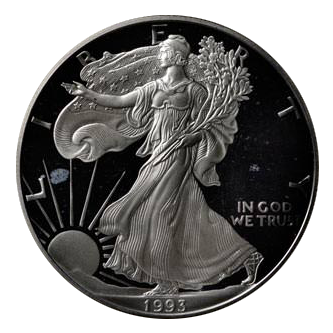
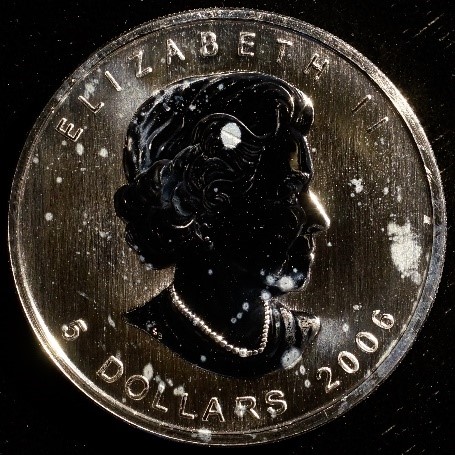
There seems to be two types: "on" the silver and "in" the silver. The first, "on" the silver spots can be cause by sneezing and/or coughing, etc. Those spots are removable according to some folks, but more on that shortly. The "in" the silver spots are not removable - period.
First, any "cleaning" of a coin to remove so-called milk spots will reduce the grade and value. The use of a commercial dip, which contains acid, actually strips away a layer of the silver. The result can be bad to horrible. My advice is - never ever try to clean a "milk" spot or any kind of spot on any coin.
Some collectors and even dealers say that a coin must be cleaned to preserve it. My response is if you're not 100% sure of the outcome, don't do anything!
As for degrading or lessening the value of a coin, the PCGS website states that "milk" spots, "…are part of the grade and grade deductions are made similar to those made for marks or hairlines
."I do buy silver with "milk" spots, but mainly treat them as bullion or junk silver depending on the severity of the spots. Personally, I would not buy a "milk-spotted" "Proof" coin. In my opinion, these spots are a flaw or damage in/on the coin.
© 2016
Called worthless by some, these rather common types of doubling are NOT Double Dies. In reality, these occurrences are due to damage. As a result, they don't carry any additional value, although some folks do collect them.
Common doubling varieties usually fall into three (3) categories: Mechanical, Die Fatigue, and Abrasion. Let's carefully look at each of these types of doubling.
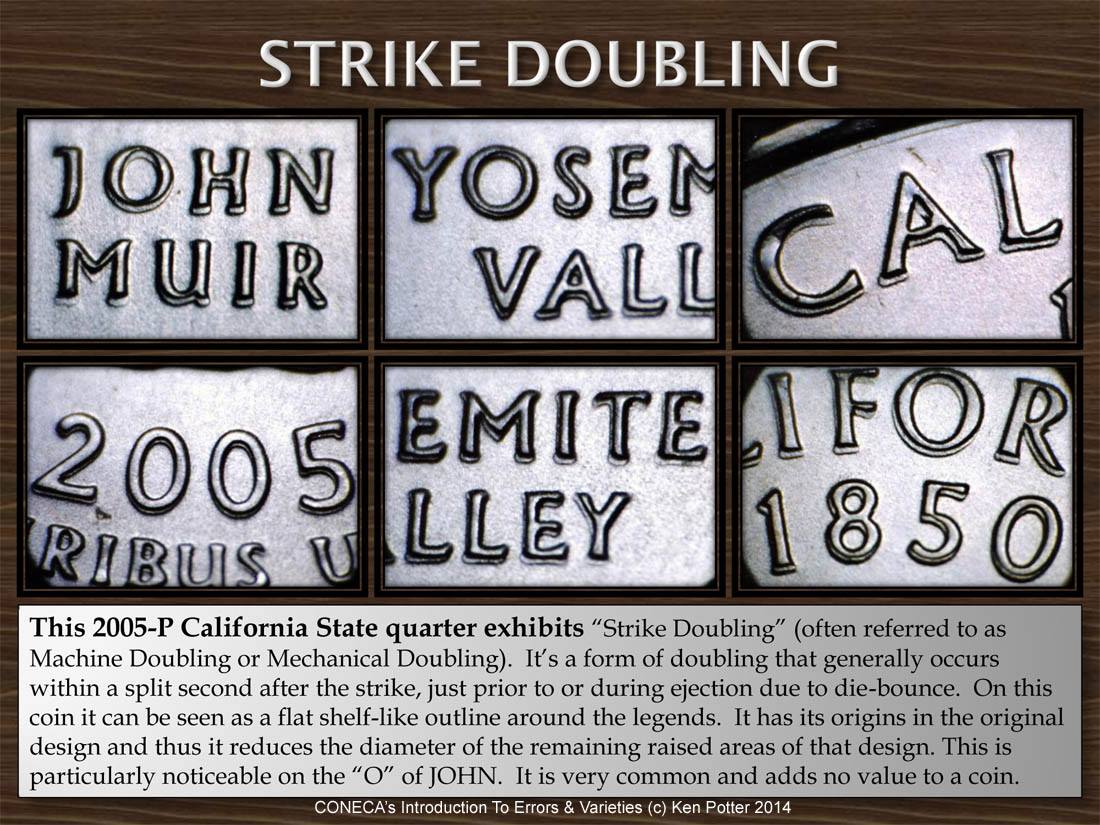
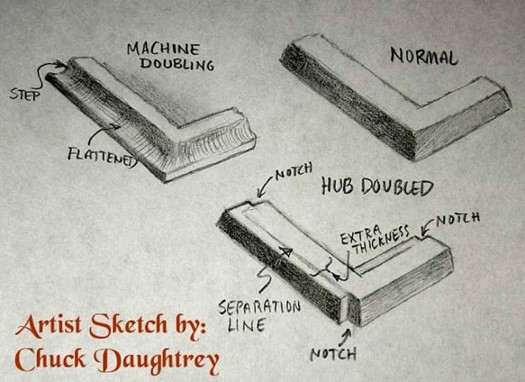
Mechanical Doubling is the most common of the three and goes by various names such as machine doubling, strike doubling, etc. Basically a flat second/duplicate image appears on a raised design element. This doubling is a result of loose part(s) on the Coining Press. This looseness is inevitable due to the constant heavy pressure pound of the Dies on the coin planchets (blanks).
Die Fatigue Doubling happens when Dies are not replaced in a timely manner and begin to wear and fail due to the actual process of minting. Even though the problem is on the Die, this too is NOT a Double Die Error. Primarily found on nickels and cents, the actual problem occurs when the metal alloy(s) resist flowing into all areas of the Die causing fatigue, aka wear, to the Die.
Abrasion Doubling is actually a result of a Mint employee attempting to correct a Die Clash issue, which causes marks to be transferred to coins, by rubbing an abrasive onto the Die itself. A Die Clash is the result of the Hammer and Anvil Dies striking each other when a planchet (blank) isn't fed into the Coining Press. This high-pressure contact leaves a portion of the Obverse (front) Die on the Reverse and vice versa
.Buyer Beware - Know the folks from which you buy and educate yourself BEFORE buying any coin, especially errors. Study photos of actual errors in a current edition of "The Cherrypickers Guide To Rare Die Varieties Of United States Coins" and other reliable sources.
© 2016
Morgan and Peace Silver Dollars are where you find VAMs. It's an acronym for "Van Allen - Mallis" and refers to die varieties involving date and mint mark. This system's goal is to catalog every die variety found. That's quite a task since new VAMs are still being found.
According to the fine website VAM World, "VAM-1 is always the normal die state for a specific date/mint and has no distinguishing characteristics. Die varieties that can be distinguished from each date/mint's VAM-1 are subsequently numbered incrementally (VAM-2, VAM-3, etc.) Sometimes a letter follows the number, i.e. VAM-1A. A "lettered" VAM represents a later stage of the numbered die that has a die gouge, major die crack, pitting, die clash, or any other result of a post-die-production occurence [sp] that can be shown to have changed the die. Like VAM numbers, letters are also assigned in a one-up fashion.
"Keep in mind that VAM numbers for a specific date and mint mark are exclusive to that date and mint mark. There is no crossover. For example, an 1880-O VAM-2 does not have the same distinguishing characteristics as a 1882-S VAM-2." Fortunately this website carries a list of the top VAMs.
You can even join the Society of Silver Dollar Collectors (SSDC) to keep up with the latest VAMs. More information can be found on this website.
Before you ask, "Yes I do have a VAM - 1882 Morgan Silver Dollar Vam-25, which has a doubled "2" on the date.
Like other varieties and errors, VAMs are a bit pricier than "normal" coins, but it's a neat specialty.
© 2016
Marc Bazzle wrote, "…Could you explain how they accidentally made 1943 Copper Wheaties and 1944 Steel Wheaties? And also, what do those go for? I understand if you would like to save that for another topic. I always had a fascination and curiosity for this innocent error of great magnitude though. I heard one way this could have happened, but would much rather hear straight from an expert of the field. Thank you my friend."
Both the 1943 Copper Wheat Cent and the 1944 Steel Wheat Cent are errors - rather valuable ones at that. Often referred to as "off-metal" Cents the widely accepted cause is that incorrect planchets/blanks found their way into the coining process, usually as a result of being caught/hidden in the recesses of the hoppers that hold planchets/blanks.
There also is a different story of how the 1943 Copper Wheat Cent occurred. After Belgium was liberated from Nazi Germany in WWII, the U.S. Mint produced 25 million two franc coins. They were similar in copper content and size, but weighed slightly less than a Copper Cent.
Unfortunately, there are many counterfeits of this 1943 Copper Cent. A Zinc-Coated Steel Cent of that date was simply dipped into copper. You can detect this sort of fake by using a magnet. The counterfeit, having a steel core, will stick to the magnet. I have one of these in my collection. Some counterfeiters carefully cut away half of the "8" on a 1948 Copper Wheat Cent. You see on the real 1943 Copper Cent, the "3" extends well below the other numbers of the date, which is detectable under magnification. It also results in a less sharp date. One final test is weight. A 95% Copper Cent weighs 3.11 Troy grams, but Zinc-Coated Steel Cents weigh 2.5 Troy grams. You'll need a good digital scale that weighs in 1/10 or 1/100 of a Troy gram.
The 1943 Copper Wheat Cent is the more common of these two errors. They fetch more than $10,000 each.
Some enterprising con artists create counterfeit 1944 Steel Cents by dipping a real 1944 Copper Cent in zinc, carefully polishing the finished product if needed. Again, the weight difference explained above would come into play when determining counterfeits.
These are the rarer of the two with just a few being released from the U.S. Mint. 1944 Steel Cents have a sale-point of approximately $100,000.
I enjoy collecting Error Coins, while at the same time educating myself in common and even uncommon counterfeits. As with anything else in coin collecting stay informed and exercise common sense, especially with these cents!
© 2016
Before starting this series, please go back and re-read my tip on the Minting Process. You see, only true errors are caused when something goes amiss in the Minting Process. All other anomalies, aka irregularities, are called Varieties, which I'll discuss in a later series.
There are many types of errors caused by the actual Minting Process. My goal is to cover what I consider to be common errors in the Minting Process.
I've only been seriously collecting U.S. coin errors for a little over three (3) years. Yes, I've learned a lot through reading and studying coins - 100,000 cents alone so far this year, but I also have a lot to learn.
At the very minimum you need a good loupe and a soft, dark cloth - black is best - for examining coins for errors.
Each part of this series will only describe two (2) errors. I'll also include photos from my collection to illustrate each.
© 2016
Let's get started and plunge right in with our study of Coin Errors. Hope you enjoy this fun tour.
DIE BREAK
Simply stated it is a chip out of one of the two (2) dies in the Coining Press. The result is that metal from the planchet/blank flows into the crack causing a raised area. Often it looks like a blob.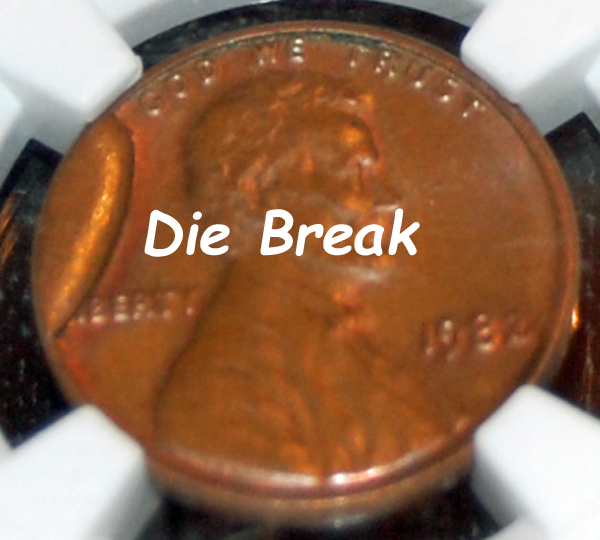
DIE CRACK
In this error, an actual crack forms in one of the two (2) dies in the Coining Press. The result is the same as with a Die Break. It appears as a raised line on the coin's surface.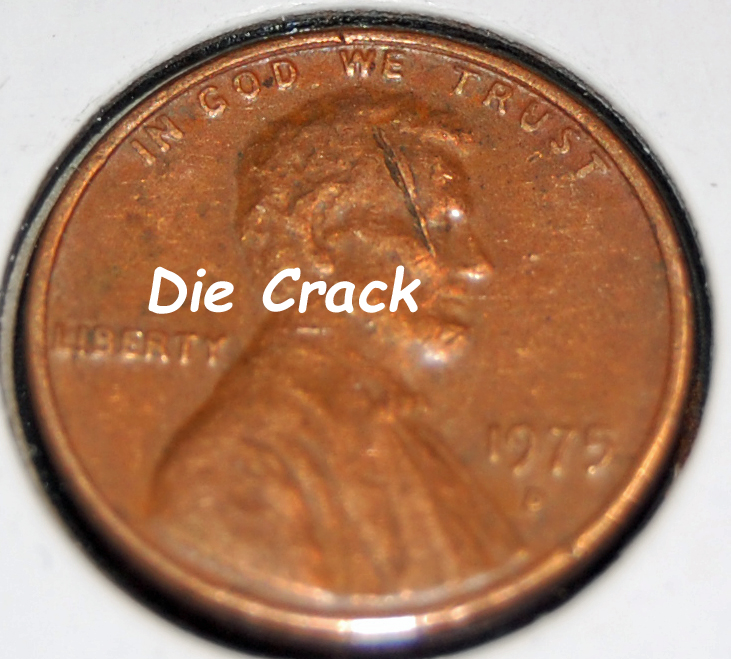
© 2016
Here are IMHO two more common errors.
LAMINATION
This error has two (2) possible causes: improper annealing or the presence of impurities in the actual planchet, aka blank. The result can be anything from a crack to actual peeling.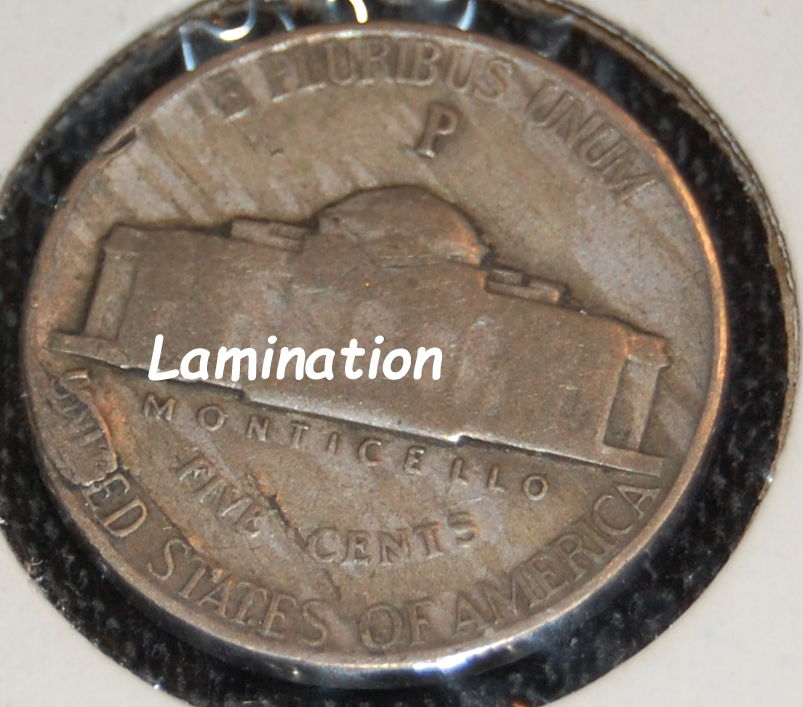
CUD
Die deterioration is what causes a portion of the edge of that die to fall off. The result is a blob-like blank area from the rim to the edge of the coin.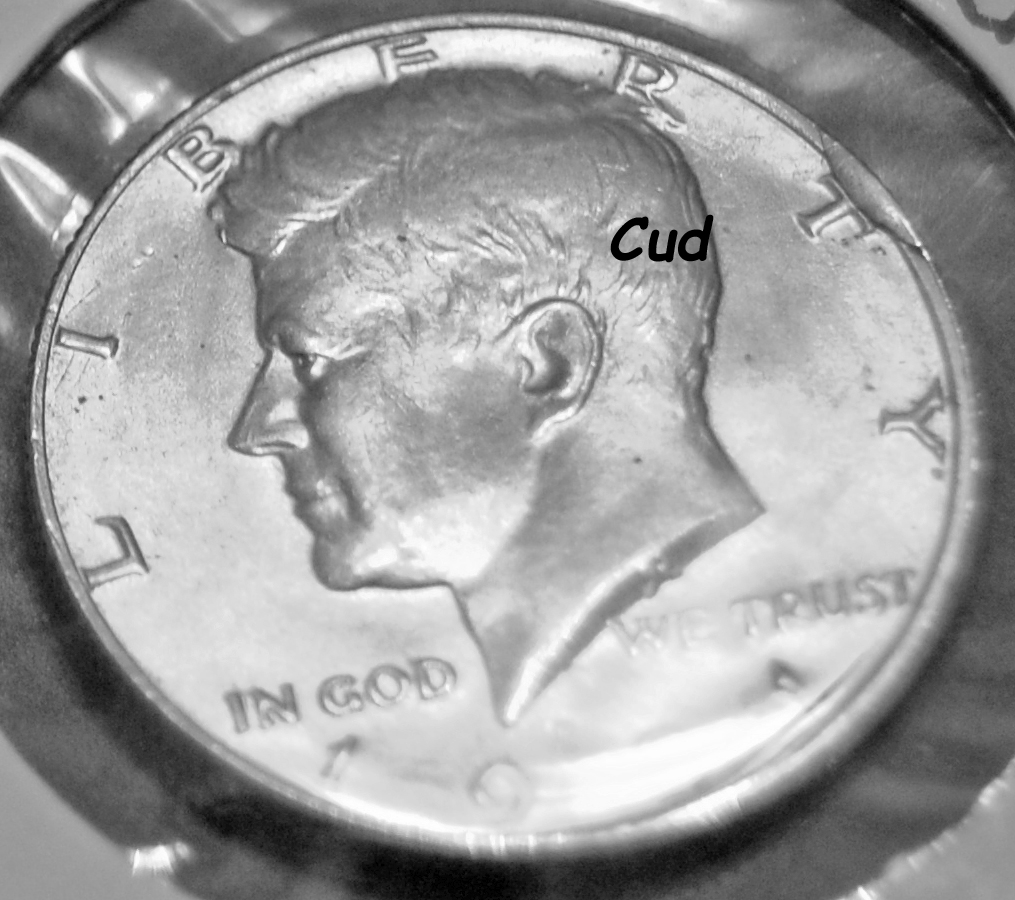
© 2016
Here are a couple more of common coin errors.
OFF METAL/WRONG PLANCHET
Simply stated, a planchet/blank with the wrong alloy planchet is used, which usually results in a smaller or bigger coin than is common for that denomination. For instance, a half-dollar struck on a quarter blank. Most commonly, the incorrect planchet becomes caught in the bin holding the blanks when it is dumped.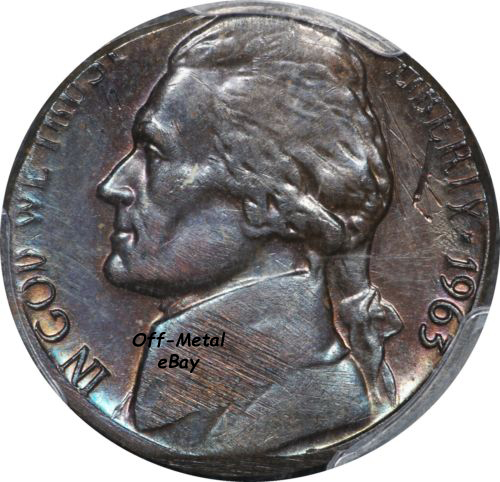
OFF CENTER
This is one of the easiest to spot. The coin just looks wrong because the planchet/blank doesn't get placed properly in the Coining Press. The coin can be missing just a small part to almost all of the design.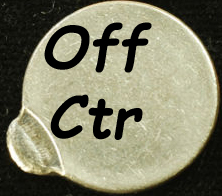
© 2016
Two more of the errors you can find and collect follows.
BROADSTRIKE
This is a result of the collar - the circular die surrounding the lower die - malfunction. The result is a plain edge on the coin. These errors may be centered or off-center, but regardless, there is no missing letter or part of the design.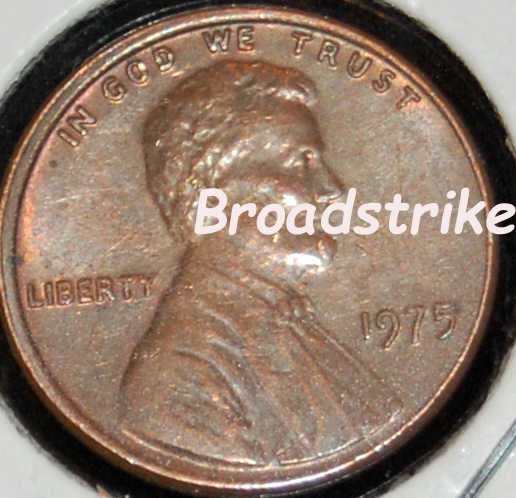
DIE CAPS
They occur when a coin is struck but sticks to the die for numerous strikes. As a result, the metal of the coin flows up around the die and the coin takes on the shape of a bottle cap.
© 2016
Here are IMHO two rather uncommon coin errors.
INDENT
Two overlapping planchets enter into the striking chamber at the same time, with the result being a blank area on each where the overlap occurred.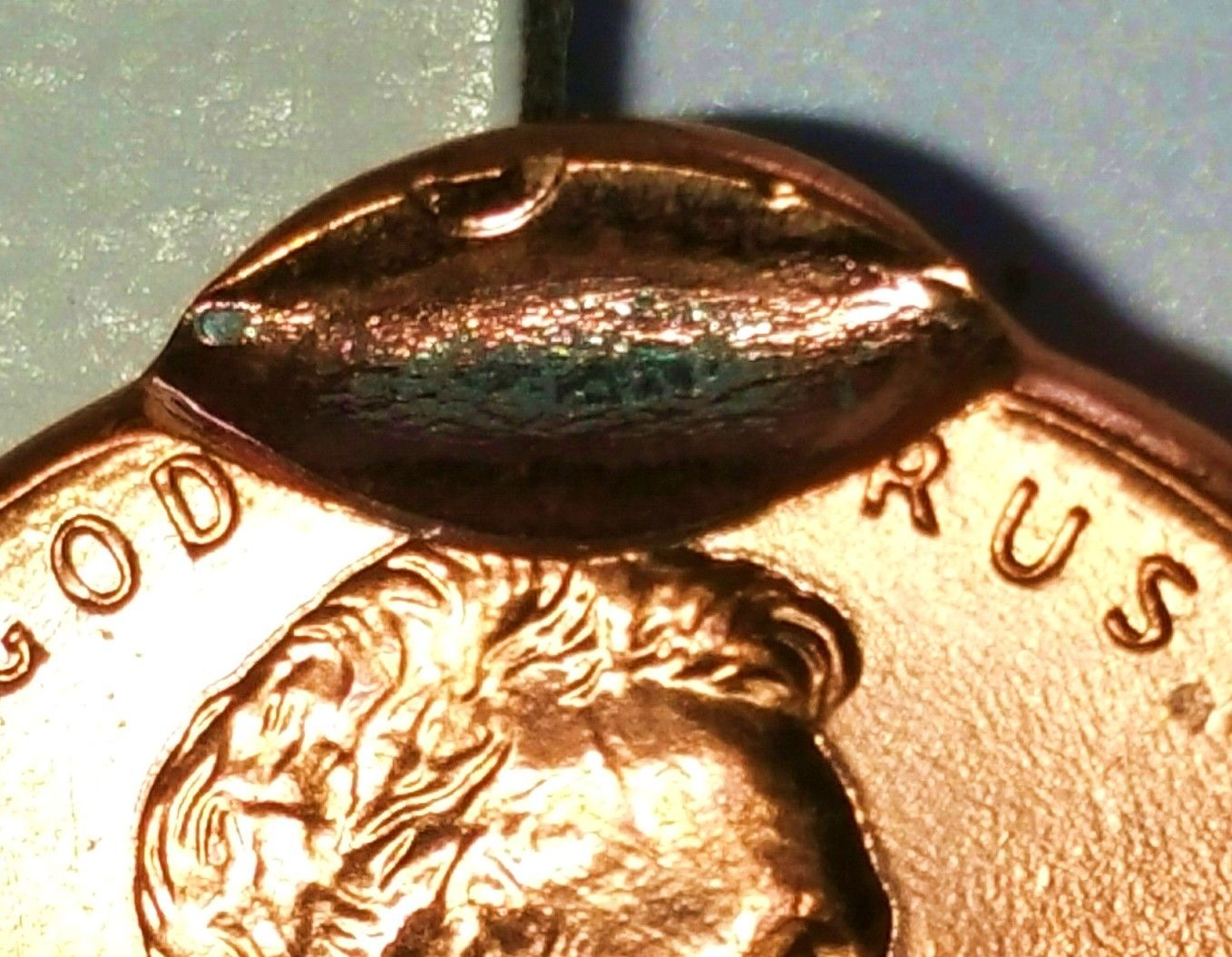
BROCKAGE
Similar to an Indent, but in the error an already struck coin is struck into a planchet/blank. The result is a mirror impression on the planchet that can be distorted.© 2016
Here are yet another two (2) more interesting coin errors.
FILLED DIE
Usually seen as missing letters or numerals, they are "filled" by grease, debri, and/or dirt which prevent the planchet/blank from being properly struck by the die.CLASHED DIES or DIE CLASH
One or both of the dies are damaged when they strike each other without a planchet/blank in place. This results in a distorted image on one or both of the dies. A well-known example is the "Bugs Bunny" error found on 1955 Franklin half-dollars. In this case, part of the eagle's wing on the reverse gives Franklin protruding teeth on the obverse.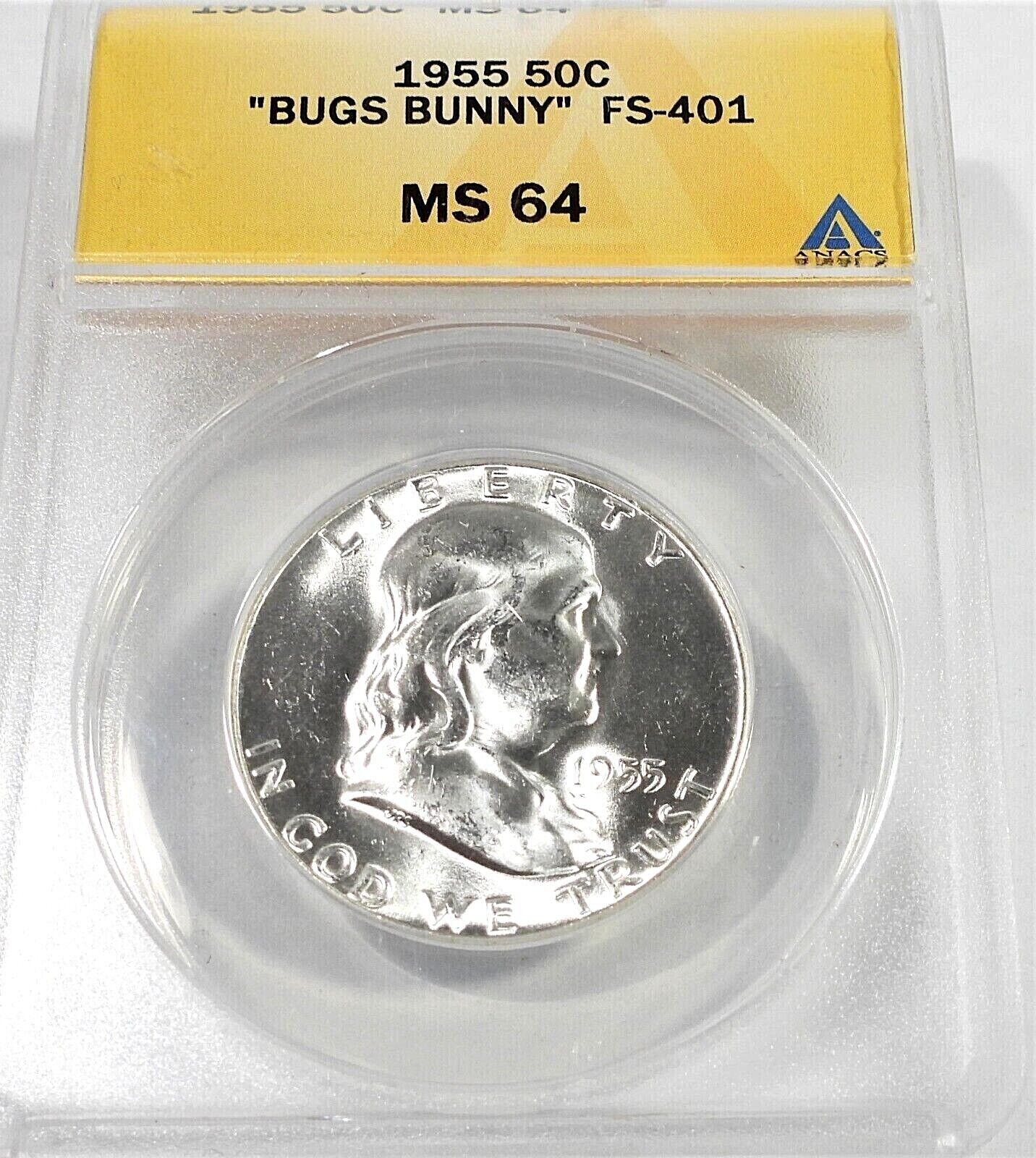
© 2016
Here are two (2) more not as common errors.
SPLIT PLANCHET/BLANK
An impurity in the planchet/blank is the cause of this error, when it partially or fully splits the planchet in two - obverse and reverse. The characteristics of a complete split is determined by whether the split occurred before or after the coin was struck.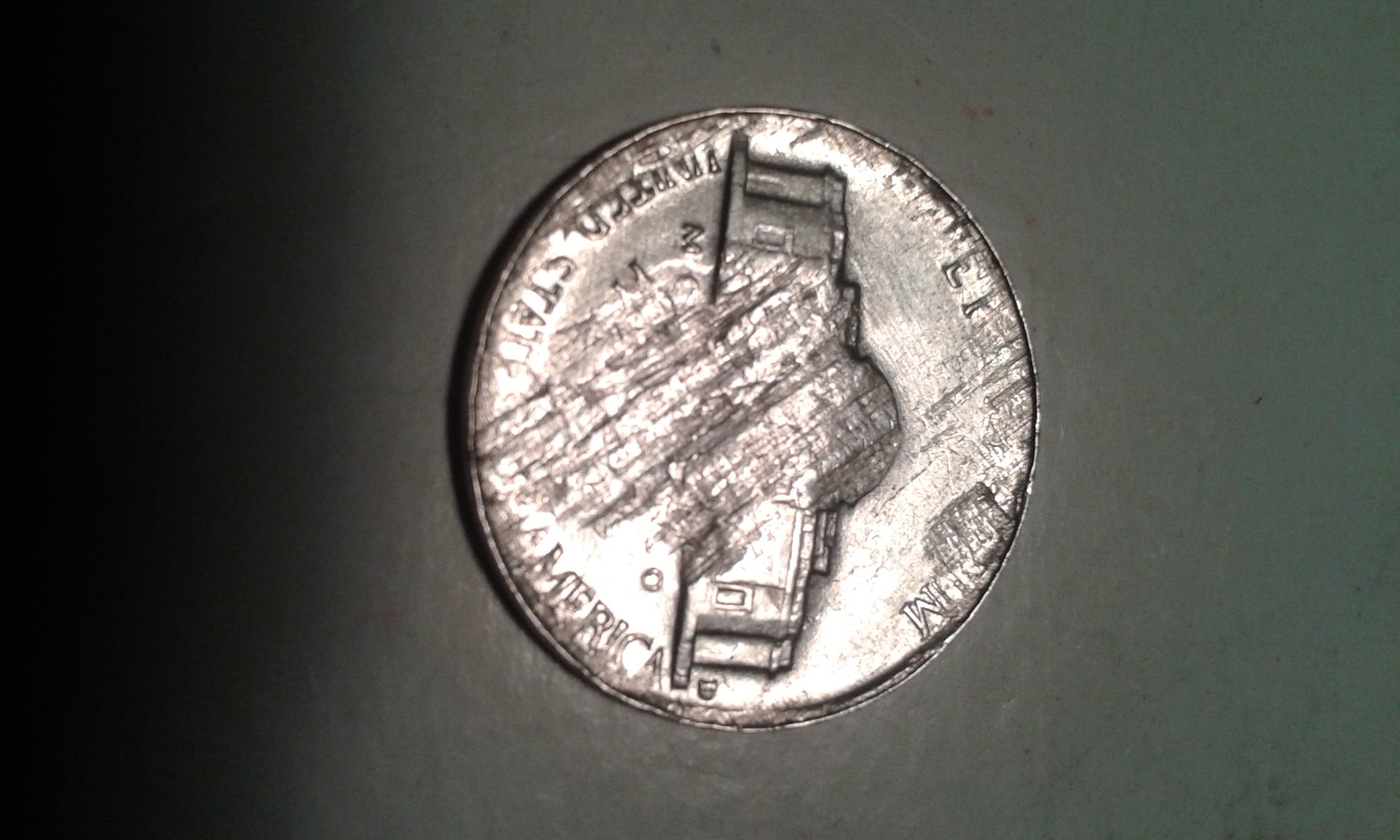
STRUCK THROUGH
This error is the result of a foreign object being on the top of the planchet's surface as it is struck. The impression of the foreign object appears on the coin.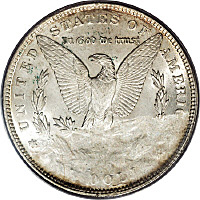
© 2016
Dan Hedden writes, "Only my opinion but FOR ME any tips or ideas is appreciated. Even if it is something some people know, others may not. If you are trading your own time to share knowledge with the rest of us, I for one will read everything you post. I don't think any of us would complain, even if stuff we know, a refresher doesn't hurt.
My real interest is errors, varieties, and things that a common person could still find (normal, meaning no millionaire)."
Ah, inexpensive errors and varieties - they're out there. The latter, varieties, can usually be found for less money. I've also found and purchased nice slabbed and raw errors for less than $20 each. Since I specialize in cents, as well as nickels that alone keeps my costs down.
I've found a number of nice varieties and some errors by "cherrypicking". Simply stated, I buy rolls of cents and nickels at banks and search through them. I then cash back in those that are not varieties or errors.
I also buy bulk lots of Wheat Cents to search through. I then sell the error- and variety-free batch to other Wheat Cent collectors.
As the Nebraska State Representative for CONECA (Combined Organizations of Numismatic Error Collectors of America) - check out their website. I'd be happy to help you with your quest. Just send me a PM.


© 2016